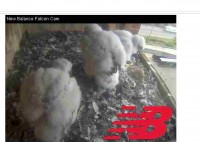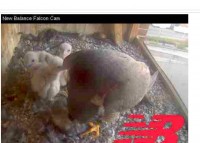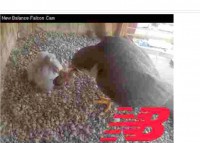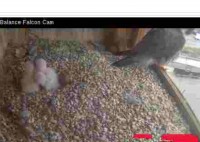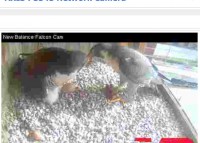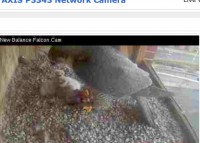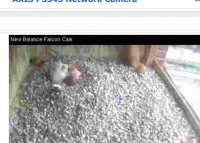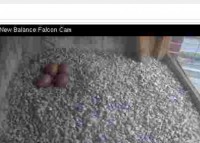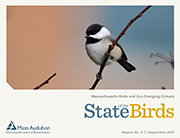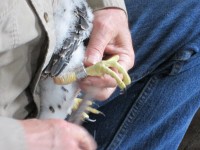 Three peregrine falcon chicks roosting above the New Balance factory were pronounced healthy Tuesday and fitted with federal and state tracking bands to help Mass Wildlife biologists and local volunteers keep tabs on them.
Three peregrine falcon chicks roosting above the New Balance factory were pronounced healthy Tuesday and fitted with federal and state tracking bands to help Mass Wildlife biologists and local volunteers keep tabs on them.
Mass Wildllife staffers and other volunteers gently lifted the fluffy chicks out of their nesting box and used pliers to fasten metal bands around their legs.
The chicks were completely checked for health issues and to make sure they were growing and developing without major issues. They observed that flight feathers are starting to emerge.
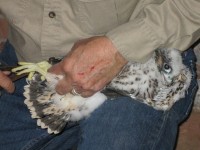 When fully fledged, the peregrine chicks will be fierce hunters that can dive at speeds of 200 mph or more to snatch other birds in mid-flight.
When fully fledged, the peregrine chicks will be fierce hunters that can dive at speeds of 200 mph or more to snatch other birds in mid-flight.
The chicks’ parents are among some 30+ peregrine falcon pairs that live in Massachusetts, favoring bridges and tall buildings where they can easily spot their prey. Based on feathers found in the nest, the falcons have recently preyed on Bluejays and Pigeons.
The mother falcon, sleek and gray with a banded gray and white belly, squawked furiously as Mass Wildlife staffers and volunteers opened the back access hatch of the nesting the box. All the humans wore appropriate gear for protection from her talons. The babies squawked at a higher pitch, then bleated as the falcon banders gently reached in to secure each chick for banding.
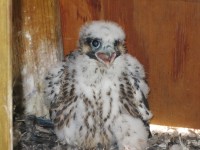 There were three chicks along with one unhatched egg. Overall, all were healthy. It is very normal for one chick to be a little less developed from others due to lower food allocation issues from stronger siblings At just over three weeks old, these chicks were mature enough to band, because their legs won’t grow any more, but too young to fly away.
There were three chicks along with one unhatched egg. Overall, all were healthy. It is very normal for one chick to be a little less developed from others due to lower food allocation issues from stronger siblings At just over three weeks old, these chicks were mature enough to band, because their legs won’t grow any more, but too young to fly away.
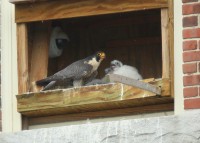 The Lawrence Peregrine fledglings continue to grow and get bigger. The female in this photos is tearing apart prey and feeding it to the chicks. The nestbox is getting crowded and the meals are more frequent. The chicks are spending more time near the front of the nestbox! The are now using their legs fully and no longer sitting on tarsi. Banding time is very close at hand.
The Lawrence Peregrine fledglings continue to grow and get bigger. The female in this photos is tearing apart prey and feeding it to the chicks. The nestbox is getting crowded and the meals are more frequent. The chicks are spending more time near the front of the nestbox! The are now using their legs fully and no longer sitting on tarsi. Banding time is very close at hand.



